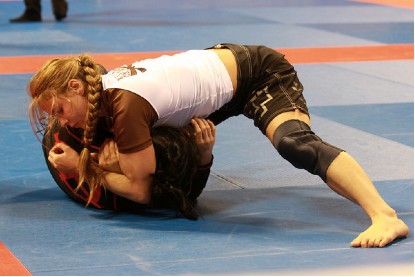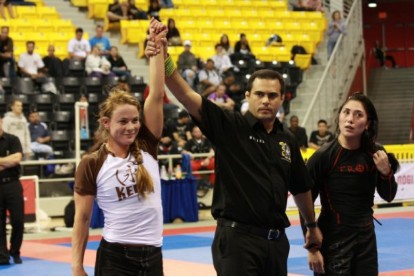Sophia’s Journey
From Separated Shoulder to BJJ World Champion
Andrew Read, RKC
March 24, 2010 12:56 PM
On the 8th of November 2009, Sophia McDermott became the first Australian female to win a world championship in Brazilian Jiu Jitsu. At thirty years of age she has spent most of her life training to compete in a variety of sports – first was five years of ballet and tap dancing, just like any little girl. Then came her first love of gymnastics. Competing for ten years, both Sophia and her twin sister Elizabeth were top national level gymnasts. However, a separated shoulder finished off her gymnastics career and that was when her life changed completely.
She began training Brazilian Jiu Jitsu in Melbourne, Australia in 2000. Quickly becoming the top national level female she moved to the United States to train at Rigan Machado's Academy before being the only girl ever invited to train full-time at the Rickson Gracie Academy. Now training at Robert Drysdale's school In Las Vegas and as the reining no Gi World Champ she has come a long way.


As a brown belt she is often less experienced than the women she competes against and has sought to make the difference up with conditioning. I have known Sophia for over ten years and had the chance to meet up with her in June 2009 after I completed the RKC. She had suffered another bad shoulder injury shortly before this at the World Championships.
After speaking with her for a while it became quickly apparent that what she needed to do was find a method of strength training that wouldn't tire her out much so she could continue her skills practice on the mat. With a standard week consisting of ten hours of BJJ plus another two hours of either wrestling or Judo this isn't as easy as it sounds. Skills pay the bills and already having a skill deficit means that she needs to concentrate her efforts on BJJ training and not conditioning.
As much as you're all probably thinking that this is where I introduced her to the kettlebell and the rest just fell into place that would be wrong. In fact, I spent a lot of time giving her my reasons why she should stay away from any form of external resistance training.
For starters, she competes right at the top of her weight class and has to diet very strictly to get under weight to compete. Adding weight to her frame would just make this harder. Secondly, with a history of shoulder problems I had a good idea that while she was very strong, she wasn't using her body correctly. To me, there is little point in adding external resistance if the person isn't even able to hold their body correctly. So the start of our training would need to focus on rehab for the AC joint as well as strength in preparation for the Worlds.
In Hardstyle we are taught to pack the shoulders – to always work as if we are trying to stand with good posture, no matter the position we are in. This packing of the shoulders, or pulling the shoulder blades down and back creates space in the AC joint. With a history of shoulder impingement it was important that we work on ways to keep the shoulders healthy to withstand the stresses of daily training. This was going to be accomplished by creating better thoracic movement by integrating some Z drills into her warm ups plus getting her back to basics with her strength training.
Taking direction from the
The Naked Warrior I taught her how to hold a push up position while keeping her posture tight with shoulders packed in. She was quite surprised at the difference in feel for how it should feel versus what she had been doing her whole life. Once she had mastered the static hold we added in movement just as described in
The Naked Warrior – action in both directions, pulling down to the bottom of the push up and then pushing the floor away on the way up while maintaining the packed shoulder position. At this point I could see light bulbs clicking on and off in her head as she came to realizations about the way she created movement. Not only that but with her posture held correctly she was able to work pain free!
Once she had come to terms with only being able to do a few push ups at a time we went to work on full body tension. She has now gotten so good at these push ups she is able to do one arm push-ups!
Her full training plan actually follows a template set out by Kenneth Jay in
Viking Warrior Conditioning. She performs three main exercises – one arm push ups, pistols and chin ups. She performs each of these twice per week over the course of three workouts. So workout one may be push ups and chins, workout two chins and pistols with the final workout being push-ups and pistols. Sets and reps are kept low to minimize fatigue and muscle soreness. She performs three to five sets of 3-5 reps per exercise. The chin-ups are performed explosively with a slow negative.
While I'm speaking of VWC I'll also add in that it's my secret weapon that I've used this year with many BJJ competitors. However, not many of them are able to use kettlebells well enough, and with my time limited when I work with them, we have replaced snatches with either sprawl/burpees or squat thrusts. In Sophia's case we used squat thrusts (and hill sprints on alternate workouts), as I didn't trust her to be able to keep good shoulder placement during such a fast movement. We followed the same interval sequence as in phase one of VWC – 15:15 going for a maximum of 20 minutes. With tournament BJJ matches for brown/black belts only lasting ten minutes this would give her adequate conditioning.
She was amazed at the level of conditioning she was able to attain with such a limited training plan. None of her workouts exceeded thirty-five minutes, including the conditioning part, and she was able to fight through all her matches with plenty of gas in the tank. Her bodyweight stayed low while retaining the strength necessary to move her opponents around. It may seem too simple to be effective, but then that's the sort of comment I've come to expect from using Hardstyle methods with my clients. The funny thing is, that while others may question the training, few can argue with the results!
Andrew Read, RKC, is head of Dragon Door Australia (DragonDoorAustralia.com) and can be contacted at andrewread@dragondooraustralia.com
Back